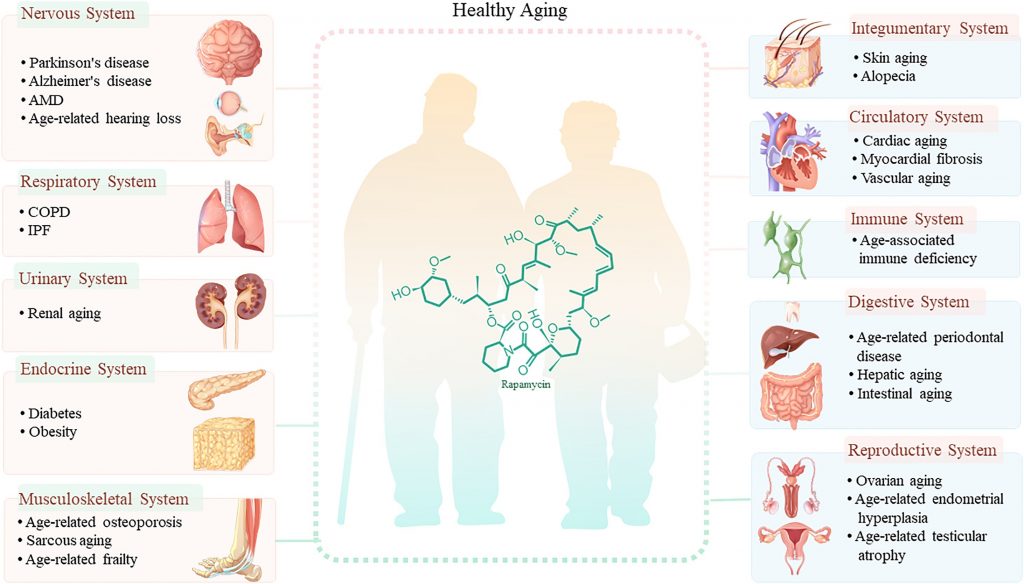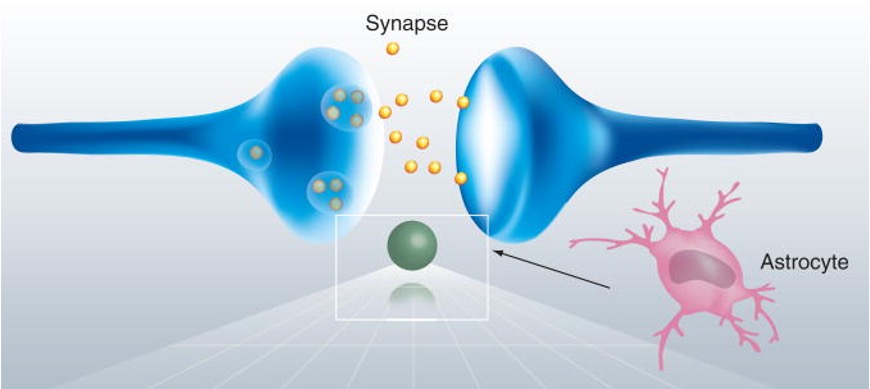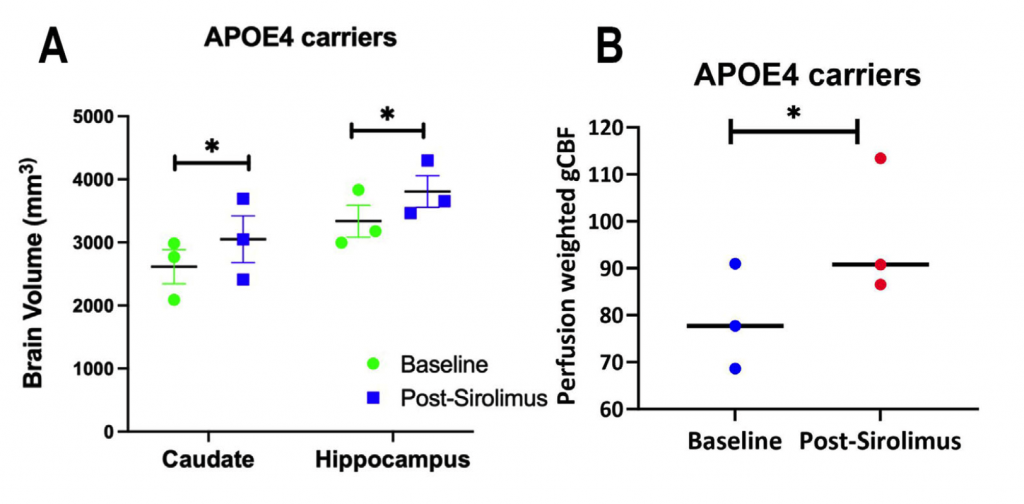Key Points:
- Rapamycin prolongs lifespan and ameliorates multiple chronic diseases in animal models, but its effects on brain aging have not been tested on humans until now.
- Having two copies of the cholesterol-transporting gene APOE4 increases the risk of Alzheimer’s 12-fold.
- Rapamycin reverses brain atrophy and increases blood flow in asymptomatic middle-aged individuals carrying two copies of the APOE4 gene.
Today there are nearly 7 million Americans living with Alzheimer’s disease (AD), the most common form of dementia. AD is the seventh leading cause of death in the U.S., suggesting that halting its progression could prolong the lifespan of millions.
Rapamycin, usually prescribed to prevent kidney transplant rejection, is now being explored for its age-slowing potential against AD and other age-related diseases. Not only has rapamycin been shown to prolong the lifespan of mice by 26%, but it also alleviates the aging of multiple organ systems, including the nervous system, cardiovascular system, and immune system.

Now that animal research has placed rapamycin among one of the most promising life-extension technologies, scientists are beginning to test it on humans. Most notably, researchers from the University of Missouri tested the effect of rapamycin on potential AD patients in a recent study published in Alzheimer’s & Dementia. Remarkably, they found that just four weeks of rapamycin treatment increased the participants’ brain volume and blood flow. These exciting results reveal that rapamycin could prevent, or even reverse the progression of AD, at least in individuals carrying the APOE4 gene.
Two Copies of APOE4 Increase the Risk of Alzheimer’s 12-Fold
We have two copies of the APOE gene, of which there are three variants: APOE2, APOE3, and APOE4. The most common variant is APOE3, whereas the rarest is APOE2. Then there is APOE4, occurring in 15% of the population, but contributing to 65% of AD diagnoses. Compared to individuals with no copies of APOE4, individuals with one copy of APOE4 have a 2- to 3-fold greater chance of developing AD, whereas those with two copies have a 12-fold greater chance.
APOE holds the instructions for ApoE proteins (Apolipoprotein E), which play a critical role in transporting cholesterol. While cholesterol has become a dirty word, it plays a vital role in the development and maintenance of neuroplasticity—the brain’s ability to change structure in response to new experiences, resulting in our ability to adapt by forming new memories. Neuroplasticity is essentially the opposite of neurodegeneration, where the structure of the brain degenerates, resulting in the loss of memories.
Our brain is the organ richest in cholesterol. Moreover, brain cholesterol levels decline with age, pointing to the cholesterol-transporting ApoE protein as a key player in brain aging and AD. However, scientists have yet to determine how the E4 variant increases the risk of AD more than the E2 and E3 variants. One argument is that ApoE2 and ApoE3 transport cholesterol more efficiently than ApoE4, leading to superior maintenance of neuroplasticity. However, there are several other hypotheses and more research is needed to confirm or deny any one of them.

Rapamycin Reverses Neurodegeneration
Carriers of the APOE4 gene exhibit brain degeneration and reduced blood flow to the brain decades before AD symptoms appear. With this in mind, Flemister and collogues, the University of Missouri researchers, tested whether rapamycin could reverse brain degeneration and restore brain blood flow in individuals carrying two copies of APOE4. To do so, they gave 1 mg/day of rapamycin to three middle-aged, cognitively normal APOE4 carriers for four weeks and compared them to two APOE3 carriers who were also given the same dose of rapamycin.
Blood flow and the volume of two brain structures important for learning memory, the caudate and hippocampus, were measured using MRI (magnetic resonance imaging). Before taking rapamycin, the APOE4 carriers displayed lower caudate and hippocampus volumes and brain blood flow than the APOE3 carriers, as expected. After rapamycin treatment, the caudate and hippocampal volumes of the APOE4 carriers significantly increased along with brain blood flow. This did not occur in the APOE3 carriers.

The authors of the study’s poster presentation stated, “We show that short-term Sirolimus treatment can effectively restore brain volumes and [brain blood flow] for asymptomatic APOE4 carriers. Specifically in the caudate and hippocampus, which play many roles integral in normal cognitive functioning including memory, learning, and emotional regulation, has considerable atrophy in AD. The findings imply that Sirolimus may be useful and effective to mitigate or prevent AD developments for asymptomatic APOE4 carriers.”
Can Rapamycin Prevent Neurodegeneration for Everyone?
Based on the findings of Flemister and colleagues, it is too early to say whether rapamycin can prevent or reverse neurodegeneration in individuals who do not carry two copies of APOE4. However, the outlook looks good for those who carry two copies. Nevertheless, only five people participated in the study, and a larger study with more participants is necessary to increase confidence in rapamycin’s neuroprotective effects against AD in APOE4 carriers.
It could be that individuals exhibiting symptoms of neurodegeneration, such as memory loss, difficulty concentrating, and confusion may benefit more from rapamycin’s effects on increasing brain volume. That is, rapamycin may not increase brain volume in people with healthy brains, but may only restore brain volume in people whose brains are already atrophied. This means that AD patients may also benefit from rapamycin. The findings of Flemister and colleagues lead to the way to exploring rapamycin’s effects on AD.
Scientists like Matt Kaeberlein, PhD, have advocated for clinical trials testing the effects of rapamycin on aging. In fact, along with physician and Youtuber Brad Stanfield, MD, Kaeberlein has a clinical trial in the works testing the effects of rapamycin on muscle strength and endurance. When it comes to AD, there are at least two clinical trials in the works, including the ERAP (Evaluating Rapamycin Treatment in Alzheimer’s Disease Using Positron Emission Tomography) Trial and the REACH (Rapamycin – Effects on Alzheimer’s and Cognitive Health)Trial.
Inhibiting mTOR to Counteract Brain Aging
The results of Flemister and colleagues, along with future clinical trials, may confirm that rapamycin is a viable treatment option for AD. Rapamycin is an mTOR (mechanistic target of rapamycin) inhibitor. mTOR is a nutrient-sensing protein that promotes growth that becomes overactive in older individuals. Studies of AD mouse models have shown that rapamycin prevents or reverses cognitive deficits, reduces AD toxic proteins, and improves neuroplasticity. It follows that rapamycin could do the same in AD patients.